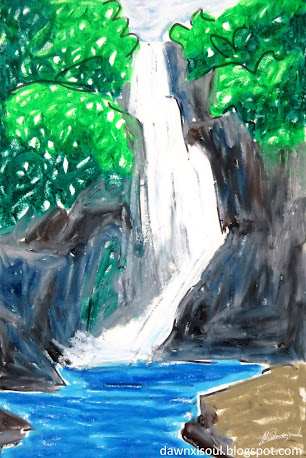March 18 (Lunar calendar: February 27), 2023 Saturday | Dawnxisoul393art
It's late autumn. Today, our family set out early in the morning to paint in the Tai Tam reservoir area in the Southern District of Hong Kong Island. When we finally faced Tai Tam reservoir, the breeze blew and looked at the quiet reservoir, freehand and comfortable. There were many tourists walking along the reservoir to enjoy the quiet scenery along the way. Tai Tam reservoir is rich in vegetation, and many plant lovers were studying and observing it carefully. Tai Tam reservoir is a group of reservoirs in the Southern District of Hong Kong. It is located in Tai Tam country park in the southeast of Hong Kong Island. Tai Tam Reservoir, including Tai Tam Upper Reservoir, Tai Tam Secondary Reservoir, Tai Tam Middle Reservoir, and Tai Tam Tuk Reservoir, was completed in phases between 1888 and 1917.
Tai Tam reservoir is the main source of drinking water on Hong Kong Island and is collectively referred to as the "Tai Tam reservoir group". In 2009, Tai Tam reservoir, together with five water facilities built before the Second World War, including Pokfulam Reservoir, Wong Nai Chung Reservoir, Kowloon reservoir, Shing Mun reservoir, and Aberdeen reservoir, were listed as Hong Kong's statutory monuments. 21 water historical buildings listed as statutory monuments in the reservoir were connected to the Tai Tam Water Heritage Trail. The Pokfulam reservoir, the first reservoir in Hong Kong, was completed in 1869. The demand for water supply was still insufficient for the public. In 1873, the government proposed the largest Tai Tam project at that time. The Tai Tam valley was selected to build the second reservoir in Hong Kong. The reason was that the site could provide a large catchment area, and expansion projects could be carried out in the future. However, the site was far from the urban area, which must overcome the problem of water transmission. Therefore, the construction team excavated the tunnel pipeline running through the Wong Nai Chung Mountains, followed by the water transmission road built on the ground according to the Wanchai Mountains to connect the filter tank and distribution reservoir at the west end.
Illustrated by dawnxisoul393
Due to the economic depression at that time and the severe wind disaster in 1874, the plan to build the reservoir was forced to shelve. The improvement of Hong Kong's financial situation in the early 1880s restarted the construction of the Tai Tam reservoir. The first phase of the project was carried out from 1883 to 1888. A dam with a height of 27.4 meters (increased to 30.5 meters in 1897), a length of 121.9 meters, and a width of 18.3 meters were built. Other projects include the construction of a water conveyance tunnel with a length of 2.2 kilometers, a water conveyance channel with a length of 5 kilometers, six filter tanks, and a distribution reservoir. After the completion of the first phase of the project in 1888, the "Tai Tam reservoir" could store 1.36 million cubic meters of freshwater. Later, it was renamed "Tai Tam upper reservoir" for identification. The storage capacity of the Tai Tam upper reservoir was still less than the population growth. Due to the lack of land on Hong Kong Island for development into a catchment area, the government decided to expand the water supply system, implement the second phase of the Tai Tam plan, and build a "Tai Tam auxiliary reservoir" to collect the freshwater overflowing from the Tai Tam upper reservoir. The Tai Tam auxiliary reservoir was completed in 1904.
On October 17, 1903, the Works Bureau submitted to the Legislative Council a draft plan for the expansion of the Tai Tam water supply system. The project was called the "Tai Tam Tuk project", which was carried out in two phases. The main dam of the dating reservoir was completed in 1917. The first phase of the construction of 900000 cubic meters of Tai Tam Chung reservoir was carried out from 1904 to 1907. In 1977, for safety reasons, the Water Supplies Department reduced the entire section of the spillway of the Tai Tam Chung reservoir dam by 3M, and the dam crest showed a slightly concave appearance. We could vaguely see the light and shadow along the bank of the reservoir and the water surface outside the dense forest. Walking along the mountain path on the bank of the reservoir also had the fun of changing scenery step by step. Looking around, surrounded by green mountains, the winding coast was light and soft. The biggest advantage of Tai Tam reservoir was not the pleasant scenery, but the concentration of scenic spots. Every few steps, there were dams, blockhouses, and other places for us to draw. The water surface of Tai Tam reservoir was clear and we could clearly enjoy the reflection of the Victorian-style ancient bridge in Britain.
Illustrated by dawnxisoul393
Tai Tam reservoir, including Tai Tam upper reservoir, Tai Tam auxiliary reservoir, Tai Tam middle reservoir, and Tai Tam Tuk Reservoir, is located in Tai Tam country park in the southeast of Hong Kong Island. Tai Tam reservoir is adjacent to Bina Mount, Jardine's Hill, Violet Hill, and Parker Hill. From different perspectives, the scenery of Tai Tam reservoir was also very different. When we first went to Tai Tam reservoir many years ago, we found that it was so beautiful. There was light shining on the water, waterfowls were playing in the water, surrounded by mountains, and eagles were flying in the sky. All this excited us. Later, we learned that what we saw was not all of the Tai Tam reservoirs. Reaching the Tai Tam upper reservoir, that was, the starting point of the Tai Tam Water Heritage Trail, which was established in 2009, covered 21 water historical buildings listed as statutory monuments. Clear signs, maps, and monument introduction boards were set up at the starting point and along the Heritage Trail.
We followed the signs to visit the monuments, European style water historical buildings, stone bridges, dams, and pumping stations of the Tai Tam reservoir, which reflected each other with the vast reservoir like a mirror, had the ancient and simple feelings of European towns, and also provided us with an endless stream of themes of sketching and painting. The water control house was located in the center of the auxiliary dam, and the wall of the house was made of granite. The stone bridge of Tai Tam Sheung reservoir and the stone waterway of Tai Tam Sheung reservoir had a history of more than 120 years. Not far ahead, we could see the first and second statutory monuments of the Heritage Trail, the stone bridge of Tai Tam upper reservoir, and the stone waterway of Tai Tam upper reservoir. The stone bridge, built at right angles to the aqueduct, spanned the spillway of the former Tai Tam Sheung reservoir. The stone bridge was supported by specially molded stone piers and columns. Up to now, it had a history of more than 120 years and was still firmly fixed and spectacular. After crossing the stone bridge and walking along the straight road on the right for about ten minutes, we reached one of the monuments of the Tai Tam auxiliary reservoir, which was located in the central water control room of the auxiliary dam.
Illustrated by dawnxisoul393
The wall of the central water control room was made of granite, while the original cast-iron safety railing still maintained its original appearance, which was very classical. Walked for another half an hour to reach another entrance and exit of Tai Tam Road country park. This entrance and exit was the final stop of the whole heritage trail, but according to the information we got, we didn't stop there, we continued to walk, crossed the road and went down along Tai Tam Reservoir Road eastward, turned left at the intersection after passing Tai Tam Scout Center and saw a small pier. The quiet pier, and the boundless sea, was a beautiful composition. Then we walked forward again and entered a wooded path, it was less than five minutes away from Tai Tam Tuk reservoir dam. The dam was a huge and majestic structure with a spillway supported by semi-circular granite columns to support the busy road linking Stanley and Tai Tam with Chai Wan and Shek O. The dam was in stark contrast to the buses and cars that ply the road. The dam was a majestic contrast to the buses and cars that travel along the road.
Then we turned back and walked in the opposite direction through the small pier again. We saw a path into the Tai Tam Tuk raw water pumping station, which was also one of the statutory monuments. It was built in 1907 with red brick walls and looked a bit like an old warehouse. Its function was to pump the freshwater from the catchment area at the southernmost end of Hong Kong Island into the intake of the water transmission tunnel in the middle of the mountain. The roof of the pumping station was made of Chinese tiles and covered the machine room. During the initial decades of operation, the machine room was still equipped with steam-driven water pumps. Later, it was expanded to include a lobby equipped with water pumps, a boiler room, an office, and a coal storage room. The pumping station was not open to the public. Visitors could only view from a distance and take a look at the structure of the inner machine room on the introduction board outside the pumping station. After the visit, the journey had come to an end. Walked back to the bus stop on Tai Tam Road and embarked on our way home. Tai Tam reservoir itself was a large art exhibition hall, which can serve as a good reference for some conservation or activation construction projects in the future.
Illustrated by dawnxisoul393
Behind the skyscraper city of Hong Kong, there are so many precious treasures hidden!
Original by dawnxisoul393,















Comments
Post a Comment